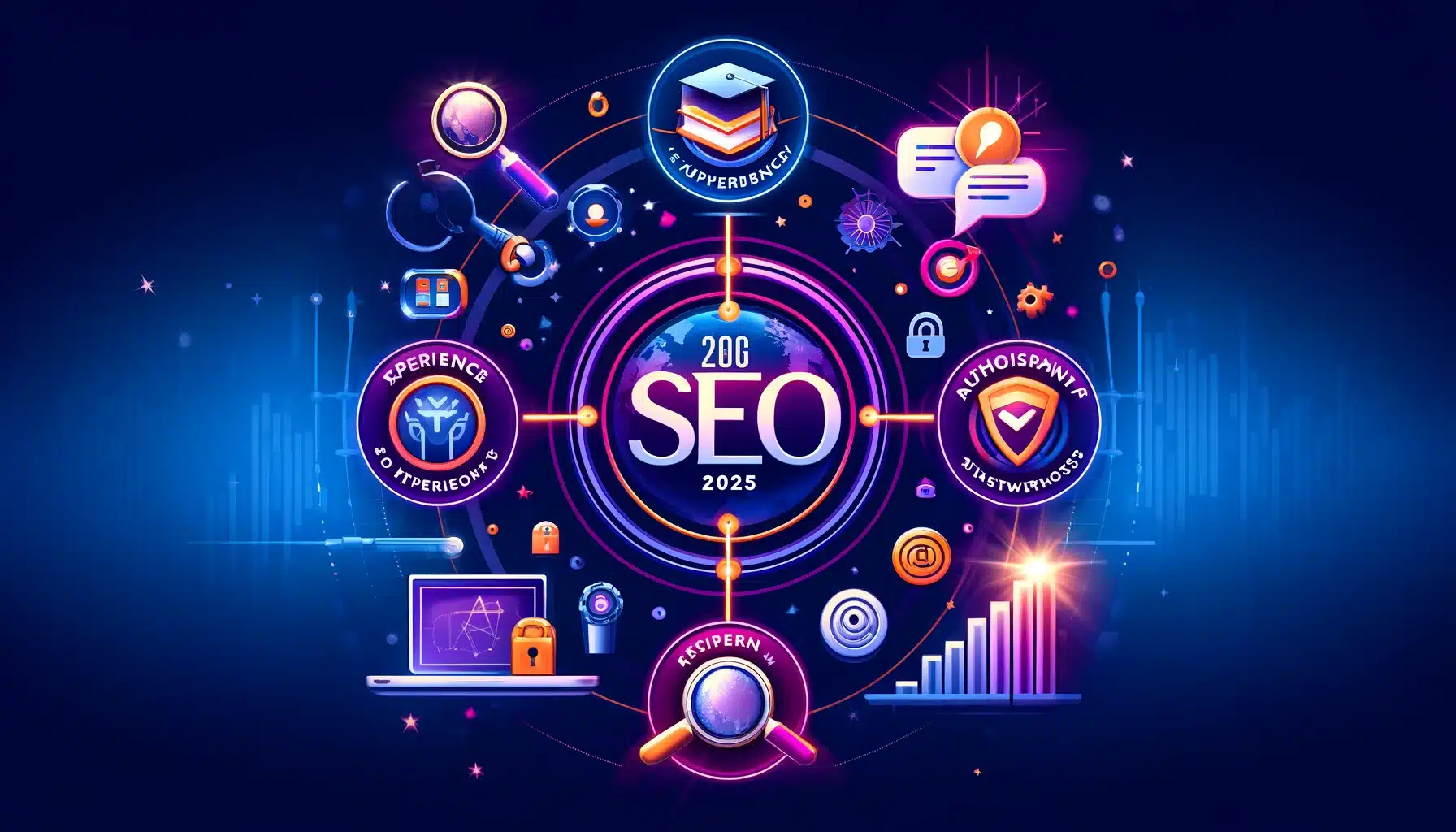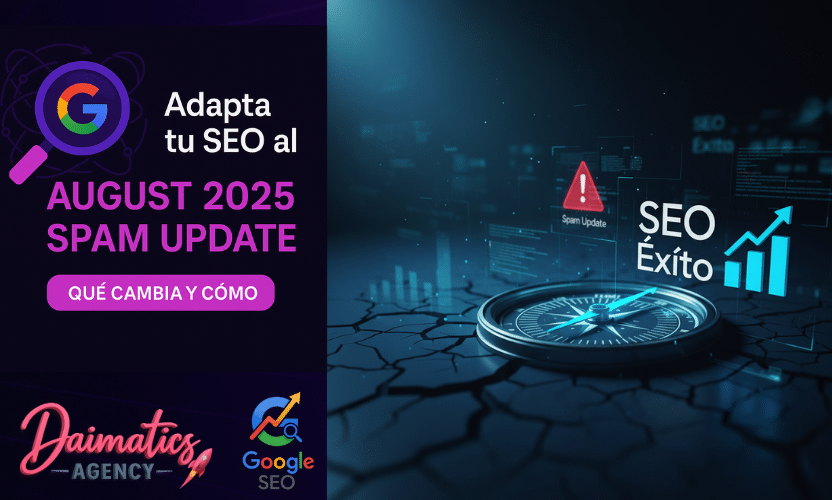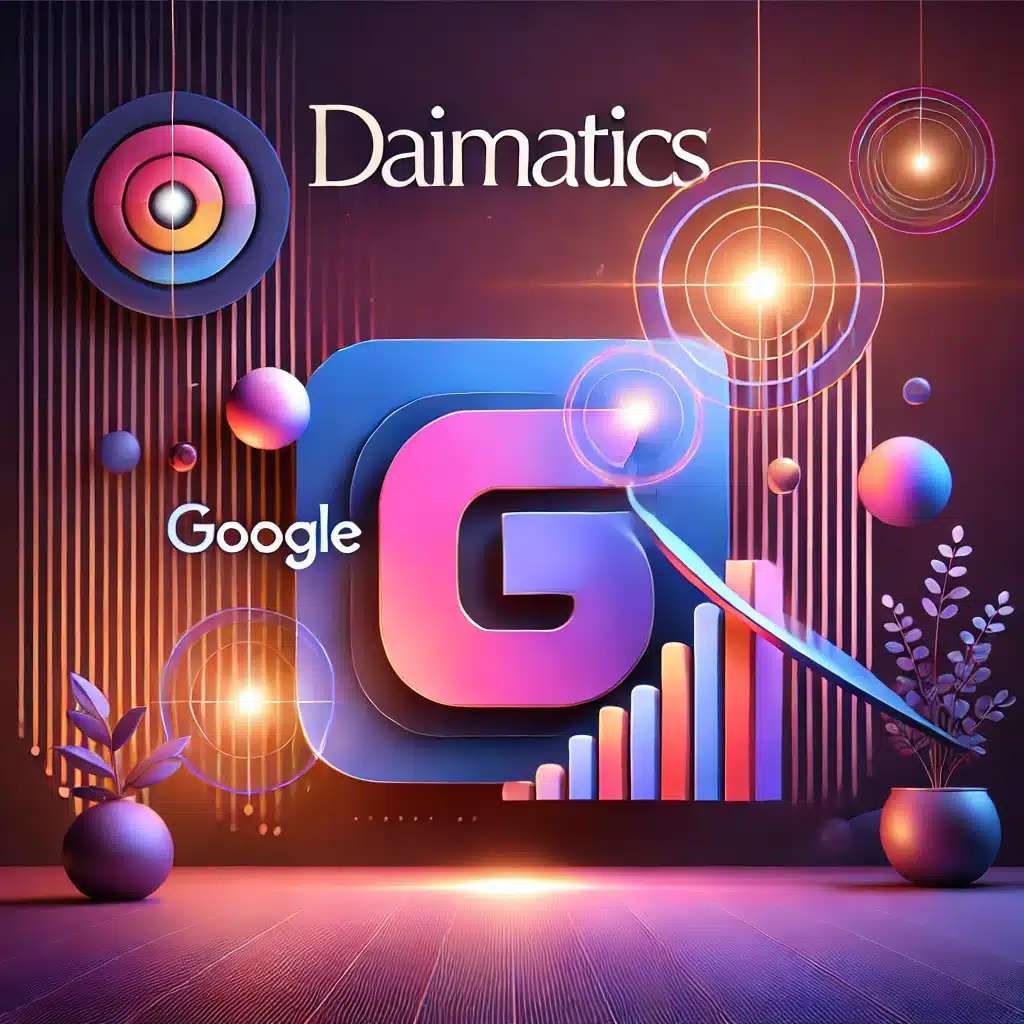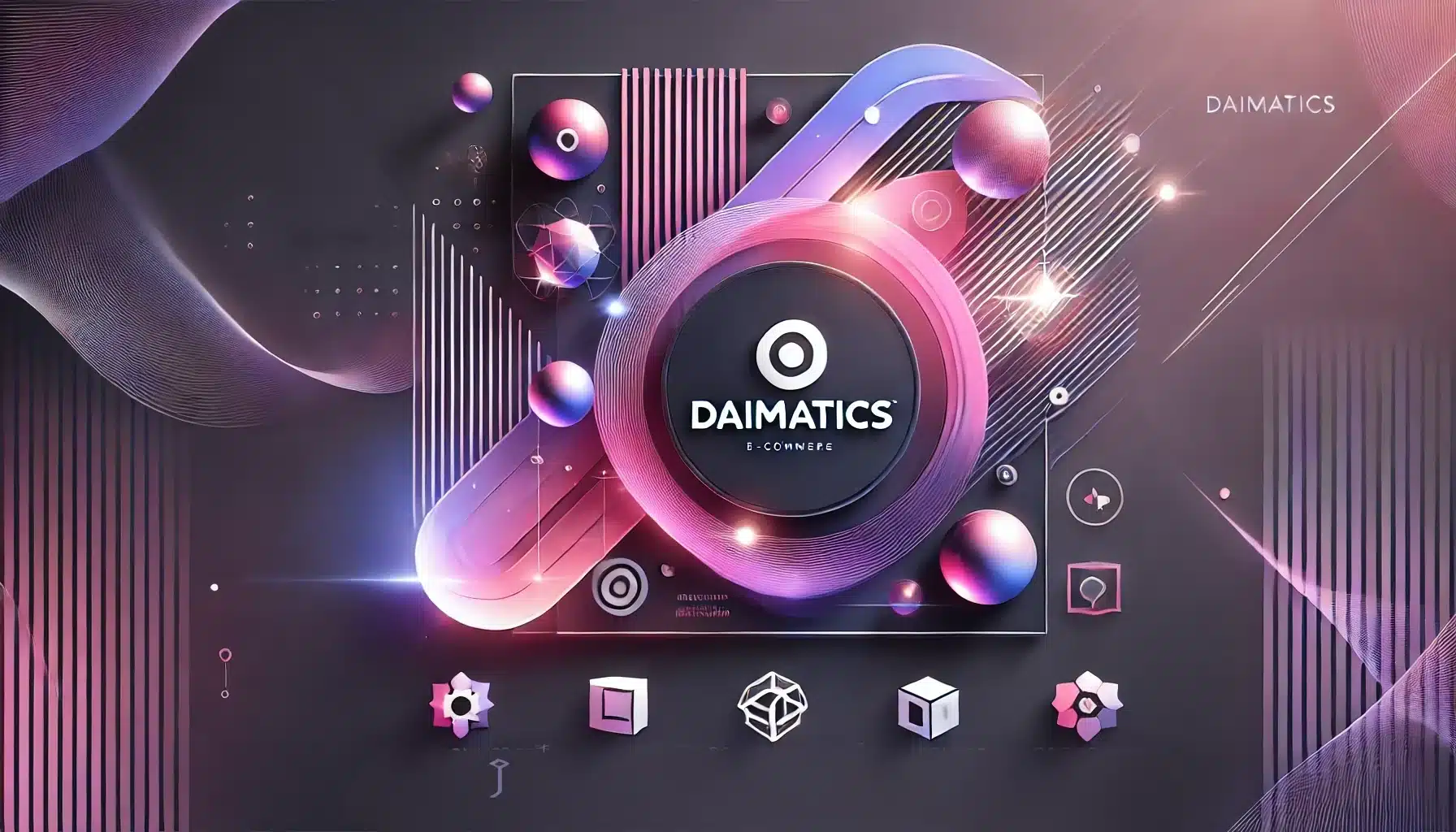Table of Contents
ToggleWhat is the EEAT?
In the world of seo, mastering the concepts that make a website gain credibility with Google is essentialOne of these fundamental pillars is the EEAT (Experience, Expertise, Authority and Reliability), a key concept in Google's guidelines for assessing the quality of web content. This criterion is especially relevant for those pages that affect users' lives, known as YMYL (Your Money, Your Life), which includes topics such as health, finance or online stores.
EEAT breakdown
Experience
The experience refers to direct or practical experience on the topic at hand. This aspect gains prominence in sectors where direct contact with reality is crucial to offering valuable content.
- examples:
- A cook who shares recipes based on his own personal experience.
- A traveler who describes routes or advice experienced in the first person.
This criterion seeks to guarantee that the content comes from people with real contact with the subject, especially in contexts where this is relevant.
Expertise
The expertise It relates to theoretical or specialized knowledge in a subject. This point is especially valuable in technical or academic subjects, where the author must demonstrate mastery of the field of content they are presenting.
- examples:
- Medical articles written by qualified professionals.
- Guides of seo prepared by certified experts in digital marketing.
Authority (Authority)
Theauthority refers to recognition within an industry. It is not just about having experience and expertise, but also being perceived as a trusted voice within your field.
- examples:
- Articles that include quotes from others authorized places.
- Collaborations with recognized institutions or prestigious brands.
Trustworthiness
The reliability It is the heart of EEAT and involves building trust for both users and Google. Transparency is key, as is ensuring that the website is safe and legitimate.
- Good practices:
- Show visible contact details.
- Have a clear privacy policy.
- to use SSL certificates to ensure a secure connection.
Why is the EEAT important for the seo?
Google prioritizes results that are not only relevant, but also reliable and valuable. The EEAT It acts as a filter to determine which pages deserve to be in the first results, especially in sensitive sectors such as medical, financial or legal.
Argumentative example
Imagine you are looking for a medical solution online. What gives you the most confidence?
- An article written by a doctor with clinical experience which includes citations to scientific studies.
- Or a blog post by an unknown author with no verifiable sources?
Google will choose the first one because it prioritizes content that reflects authority and reliability. This is why the EEAT is essential in the strategy seo.
The role of the "YMYL" in the EEAT
The contents YMYL (Your Money, Your Life) are those that can directly influence the lives of users. This includes:
- health: Medical information, health advice.
- finance: Investment guide, financial advice.
- legal: Legal advice.
- E-commerce: Online stores that manage sensitive data.
Real examples
A prominent example of the importance of the EEAT was the Medic Update 2018This Google algorithm penalized medical sites that:
- They had no verified authors.
- They published content without citing scientific studies or reliable institutions.
result: Pages with low EEAT lost traffic drastically, while sites with qualified authors and supported content gained positions.
These actions highlight that EEAT is not just a technical aspect, but a tool to ensure that users receive quality content with a positive impact on their lives.
How to improve EEAT on your website?
To increase the EEAT and to ensure that your content is valued by Google and trusted by users, it is essential to work strategically on each of its components. Here is a detailed guide to optimizing each aspect:
1. Experience (Experience)
The direct experience is key to generating credibility, especially in topics where personal experience provides unique value. Users want authentic content based on real experiences.
Strategies to highlight experience:
- Includes real testimonials: Publish stories or success stories based on the experience of your team or your clients.
- example: In a marketing blog, explain how you helped a client increase web traffic at a 50% using strategies seo.
- Demonstrate the practical use of what you explain.: Share videos, images or tutorials that show how to use a product or service.
- example: A video that shows how business management software works.
- Create experience-based content: Describe routes you've taken, products you've tried or situations you've experienced.
- example: On a travel blog, publish a guide on “The best hiking routes in Andorra”, based on your personal experience.
Expertise (Expertise)
The expertise It ensures that the content comes from deep and well-founded knowledge. This is essential for technical or academic topics.
Strategies for demonstrating expertise:
- Show ratings: Add professional profiles or biographies of authors with information about their degrees, certifications, or years of experience. This is especially relevant in sectors YMYLYou can see a complete guide to good authoring practices at Google Research Center.
- example: "Marta Garcia, consultant seo with more than 10 years of experience and Google Ads certification.”
- Includes sources and references: Link to academic studies, official reports, or authoritative articles that support your claims.
- example: When talking about “trends seo by 2025”, attached reports from Google or Moz.
- Create specialized content: Opt for articles that delve into specific topics.
- example: A step-by-step guide on “How to optimize structured data for an ecommerce”.
Authority (Authoritativeness)
The authority It is the perception that you have an influential voice within your industry. Google values pages that are recognized by other trusted sites.
Strategies for building authority:
- Generate quality inbound links: Collaborate with leading websites in your industry to link to your content.
- example: An article by SEMrush that quotes one of your marketing guides.
- Publish valuable content: Write case studies, comprehensive guides or exclusive reports.
- example: A detailed comparison of the best ecommerce platforms.
- Get involved in the industry community:
- Participate as a speaker at events.
- Publish articles in blogs or specialized magazines.
Reliability (Trustworthiness)
Trust is one of the most important pillars of EEAT, and can be fostered with transparency and security.
Strategies to increase reliability:
- Show transparency: Include an “About Us” page that explains who you are and what you do.
- example: Add information about the team, the company's mission and its values.
- Provide visible contact details:
- Make sure users can easily access your email, phone number, or physical address.
- Secure your website with SSL:
- It guarantees a secure HTTPS connection to protect user data.
- Add verified testimonials:
- Post positive reviews from real users or customers.
- example: Includes a reviews section with tags like “Verified Customer”.
Practical examples of EEAT application
Medical website:
- Publish articles written by degreed doctors.
- Includes links to scientific studies.
- Add a clear privacy policy and visible contact details.
Technology e-commerce:
- Show reviews from verified customers.
- Publish product demonstration videos.
- Ensures that pages have HTTPS and visible return policies.
travel blog:
- Share your own photos and advice based on personal experiences.
- Collaborate with other renowned bloggers.
- It publishes detailed articles such as “The best adventure activities in Andorra”.
These actions not only improve your visibility on Google, but they also generate trust in users, ensuring that your content is perceived as authorized and reliable.
Practical advantages of EEAT for your strategies seo
The EEAT is not just a Google guideline, but an essential tool for differentiate yourself from the competition and improve the quality of your website. Implementing it correctly can generate real and measurable benefits for your strategy seo. Below, we detail the most prominent advantages:
Improve user trust in your content
When a website conveys authority and reliability, visitors tend to perceive the content as useful and safeThis can have a positive impact on two key aspects:
- Stay on the page: Users spend more time reading content they consider credibility and relevance, thus reducing the bounce rate.
- Conversion: A website with high EEAT generates more trust, which increases the chances that users will:
- Sign up for newsletters.
- They buy products.
- Contact us to request more information.
Practical example:
A medical clinic with articles written by certified doctors, including references to recognized medical studies such as those published in PubMed, manages to gain the trust of potential patients. This translates into more visits and appointment bookings.
How the EEAT drives organic traffic and the seo
The EEAT is not a direct ranking factor, but has a crucial indirect relationship with how Google values content:
- Shareability: Valuable content with authority quotes it is more likely to be shared on social networks or cited on other blogs.
- Appearance in rich snippets: The well-configured structured data, com reviews or expert biographies, increase the chances of appearing in prominent formats in search results.
Practical example:
A technology article comparing devices with graphs and objective data published by sources like extra it is more likely to gain visibility in searches like “Best laptop for designers in 2024.”
Reduce the risk of penalties by Google
Google, with its increasingly sophisticated algorithms, penalizes content that misleads users or lacks credibility. Work on EEAT help protect your website from:
- Manual or algorithmic penalties derived from unreliable content, as in the case of the famous Medic Update (2018).
- Ad blocking on platforms like Google Ads, which require content transparent and verifiable.
Practical example:
Health-related websites that don't feature qualified authors or reliable studies have seen a drastic drop in traffic after Google's updates. Implement the EEAT avoid this vulnerability.
Establish your brand as a reference in the sector
A website with high EEAT can become the first option for information, products or services within your sector. This can have several benefits:
- Customer trust: Users prefer brands with demonstrated knowledge and authority.
- Strategic collaborations: Other companies can search collaborate with you if they recognize your site as a reliable source of information.
Practical example:
A sportswear eCommerce store that publishes guides signed by professional trainers can be cited by other brands or bloggers as an authority figure.
Boost your backlinks strategy
The places with high EEAT are attractive to other pages, generating more natural inbound linksThis improves:
- Domain authority: More quality links increase your credibility in the eyes of Google.
- Referred traffic: Each backlink represents an opportunity for new users to discover your site.
Strategies to improve backlinks with EEAT:
- Collaborate with places like Forbes or TechCrunch, citing your content.
- create exclusive infographics with quality data that other websites want to use.
Increase your ROAS (Return on Ads)
Google values advertising campaigns that drive traffic to safe and quality sites, improving the effectiveness of ads:
- Improvement of Quality Score: Trusted content increases your quality score, which can reduce the Cost Per Click (CPC).
- Improved profitability: A website optimized with EEAT converts better, thus maximizing return on advertising investment.
Practical example:
A legal advice page with content written by certified lawyers and positive reviews gets more leads with a lower cost per click in Google Ads campaigns.
Add useful links to strengthen the EEAT
Don't hesitate to reinforce your content with external links to authoritative sources. Here are some ideas:
- Medical studies: Link to PubMed or WHO.
- Statistical data: Use extra or Eurostat.
- seo and marketing: Includes official guides from Google or resources of Moz.
With these advantages and specific examples, it is clear that working the EEAT not only optimizes visibility seo, but also generates trust, traffic and conversions of quality
Common mistakes to avoid when working with the EEAT
Although implementing the EEAT can transform the credibility and visibility of your website, there are common mistakes that can damage your reputation and limit profits seo. Identifying and avoiding these practices is essential to ensure that your content convey authority and confidenceHere are the most common mistakes:
Not clearly defining content authority
One of the main pillars of the EEAT it's about showing who's behind the content. Google rewards transparent sites, which demonstrate the credentials and experience of their authors. Omitting this information can seriously affect the perception of trust.
- Solution: It includes detailed biographies of the authors explaining their training, certifications, and experience in the subject.
- Example of error:
A medical website that publishes general health content without indicating whether it was written by licensed doctors or accredited specialists. This may lead users to doubt the reliability of the content.
Ignoring user experience (UX)
Even if the content is excellent, a poor browsing experience can directly affect the EEAT and the perception of reliability of your site:
- Common problems:
- Slow loading time: Users abandon pages that take more than 3 seconds to load.
- advice: Use tools like Google PageSpeed Insights to optimize speed and improve both the seo technician like user experience.
- Lack of organization: Content without clear captions, visual lists or images that help with reading.
- Non-responsive design: In a world where more than 601% of web traffic is mobile, a non-adaptive design is unacceptable.
- Example of error:
A technology blog with valuable guides, but with a disorganized structure that is difficult to use on mobile devices, can lose credibility with the public.
Post content without verifiable sources
The lack of references and reliable sources is a serious mistake. Google demands content well documented to establish authority and ensure that the information is correct.
- Solution:
Includes links to:- Official institutions.
Example: In medical topics, link to PubMed, World Health Organization (WHO) or other scientific sources. - Recent studies and recognized reports.
- Recognized experts in the sector.
- Official institutions.
- Example of error:
An article that claims that “vitamins increase energy in 10 days” without citing any specific study or reference may be perceived as unreliable content.
Focus exclusively on the seo technician
Although the seo technician is essential, it cannot replace content quality and reliable. Prioritizing only keywords, meta data or technical elements, without working on authority, can result in performance seo poor
- Example of error:
A website that is perfectly optimized technically but offers generic, short, and shallow articles is unlikely to achieve good positions in search results.
Not updating content regularly
Google values the freshness of the content, especially in sectors where information changes rapidly, such as healthcare, finance, or technology. Outdated content can damage perceptions of credibility.
- Solution:
Schedule periodic reviews of articles to:- Update data and statistics.
- Add new trends and regulations.
- Improve the structure and references if necessary.
- Example of error:
A finance website with articles about 2020 tax regulations without updates for 2024 may lose traffic and trust.
Neglecting the “About Us” section and legal information
Company pages or corporate information are key to conveying transparency and trust to users and to Google. The lack of clear information can raise doubts about the legitimacy of the site.
- What to include?
- Pages with information about the company, such as its mission, values and history.
- Clear policies on privacy, returns and use of cookies.
- Visible and accessible contact details.
- Example of error:
An eCommerce without a clear returns page can cause users to abandon the purchase process due to distrust.
Do not respond to user comments or questions
Interaction with visitors is a fundamental part of demonstrating accessibility and reliabilityNot responding to comments or ignoring questions can create an image of indifference.
- Solution:
Implement a system for responding to comments in a timely manner. This builds trust and encourages engagement. - Example of error:
A cooking blog with recipes that does not answer readers' questions about ingredients or cooking times can lose followers and credibility.
Post duplicate or superficial content
Google severely penalizes content that does not provide value or that reproduces existing information without any modification or added context.
- Solution:
Prioritize the creation of original and extensive content that delves into topics. - Example of error:
A travel website that copies guides from other blogs without adding personalized advice or real experiences from the authors.
Avoiding these mistakes will make a difference
Correcting these weaknesses ensures that your website will not only comply with the standards of EEAT, but it will also stand out from your competitors as a source authorized, reliable and relevant.
Examples of EEAT application in key sectors
The EEAT (Experience, Expertise, Authority and Trustworthiness) has a practical application that can significantly differentiate your website in key sectors, especially those where accurate information and trust are essential. Here's how it can be effectively implemented in different areas to maximize its impact.
Healthcare and medical sector
In the medical field, Google demands extreme credibility because any error can have serious consequences for users. This makes EEAT indispensable.
- Recommended practices:
- Publish content written by accredited medical professionals and clearly display their qualifications.
- Includes links to scientific studies or recognized associations such as theWorld Health Organization (WHO).
- Update the content periodically to ensure that the data is current.
- Practical example:
A clinic publishes an article on “How to Manage Anxiety During the Pandemic” written by a registered psychologist, with references to scientific studies. This strategy not only strengthens user trust, but also improves organic positioning.
Financial sector
Transparency and accuracy are crucial in the financial arena, as users rely on this data to make critical decisions.
Recommended practices:
- Create content written by certified economists or financial advisors.
- Use links to official sources such as the European Central Bank or other recognized financial organizations.
- Includes up-to-date infographics and charts that explain complex topics.
Practical example:
An article titled “How to Plan Your Retirement in Spain” includes a comparison of pension plans, official data, and opinions from a certified advisor. This increases both the trust and authority of the website.
E-commerce
In e-commerce, user trust is essential to ensure conversions and repeat sales. Here, EEAT plays a crucial role.
Recommended practices:
- Add verified customer reviews and use structured data to display ratings in search results.
- Publish guides or recommendations created by industry experts.
- Make sure pages include clear return policies and visible terms and conditions.
Practical example:
An appliance store publishes an article titled “The Best Coffee Makers of 2024” written by a professional barista. The article links to product details and includes verified testimonials, improving credibility and driving sales.
Education
Educational platforms must demonstrate expertise and authority to be perceived as trustworthy by students and professionals.
Recommended practices:
- Publish content created by qualified teachers or education professionals.
- It includes practical examples, case studies and quotes from recognized pedagogical studies.
- Create interactive spaces such as forums or webinars to encourage participation.
Practical example:
An online academy publishes a guide on “Advanced Study Techniques for Official Exams.” This guide, created by accredited educators, includes case studies and links to reliable external resources. This increases the perception of authority.
Tourism and hospitality
Travelers often look for recommendations based on personal experiences and advice from local experts. Authentic content and verified reviews are key here.
Recommended practices:
- Publish guides with details and personal recommendations from local experts.
- Includes verified traveler reviews and real images of destinations.
- Use videos and image galleries to reinforce authenticity.
Practical example:
A tourism blog publishes “The best things to do in Costa Brava.” The content includes real photos of the beaches, testimonials from other travelers, and practical tips from a local guide. This improves the authority and trustworthiness of the site.
technology
Technology users seek accurate and well-documented content to make informed decisions about technical products and services.
Recommended practices:
- Publish detailed product comparisons with objective data and performance tests.
- Collaborate with engineers or technical experts to ensure content is authorized.
- Add links to user testing and recognized technical sources.
Practical example:
A technology website publishes a comparison of “The Best Laptops for Programmers in 2024.” The content includes performance tests, graphs, and opinions from tech experts. This builds user trust and increases organic visibility.
Apply the EEAT strategically in these sectors not only helps to improve the positioning seo, but also generates trust and loyalty among users. This cross-cutting approach ensures that your website is perceived as a reliable and authoritative source in your sector.
Practical strategies for implementing the EEAT
The EEAT (Experience, Expertise, Authority and Trustworthiness) is not just a theoretical concept; it also involves concrete actions that can improve the perception of your website by both users and search engines. Here is a set of strategies to implement it. EEAT effectively.
Author and Credential Optimization
Showing who is behind the content is essential to building credibility.
- Detailed biographies: Each article should include information about the author, such as their experience, certifications, and other relevant credentials.
- Links to professional profiles: Connect authors with their LinkedIn profiles, research pages, or professional networks.
- Signatures on YMYL content: In sectors such as healthcare or finance, clearly specify the authors' titles and their experience.
Practical example:
A medical article written by a doctor can include a biography that mentions years of experience and a link to their professional profile. This reinforces the trust of the reader and the search engine.
Data-driven content creation
Content that includes verifiable and updated data is more likely to be perceived as reliable.
- Includes external sources: Cite scientific studies, official reports and link to recognized organizations.
- Constant update: Periodically review the content to add new data, statistics or trends.
- Infographics and visualizations: Use graphs and charts to make data easier to interpret.
Practical example:
A financial blog publishes an article with the latest data on interest rates in the European Union, linking to sources such as the European Central Bank or reports from rating agencies.
Improving transparency
Transparency builds trust, both for users and for Google.
- “Who we are” page: Tell the story of your company, its values and its team.
- Visible privacy policy: Make sure users understand how their data is managed.
- Verified Reviews: Post testimonials with photos or videos to prove authenticity.
Practical example:
An eCommerce includes a section where customers can see verified product reviews and testimonials from real users.
Website security
A secure website generates immediate trust in both users and search engines.
- SSL Certificates: Implement HTTPS to protect user data.
- Data protection policies: Complies with regulations such as GDPR and explains how data is managed.
- Visibility of contact data: Provide clear information such as phone numbers, addresses, and emails.
Practical example:
A health site that uses HTTPS and has a clear contact page will be perceived as more secure by users.
Promoting collaborative content
Working with external experts and collaborative publications can strengthen your authority.
- Invite experts: Publish content written by industry professionals.
- Quotes and interviews: Integrate opinions from influential figures to support your content.
- Case studies: Collaborate with companies or institutions to show real examples.
Practical example:
An education platform may include interviews with university professors about the best learning techniques.
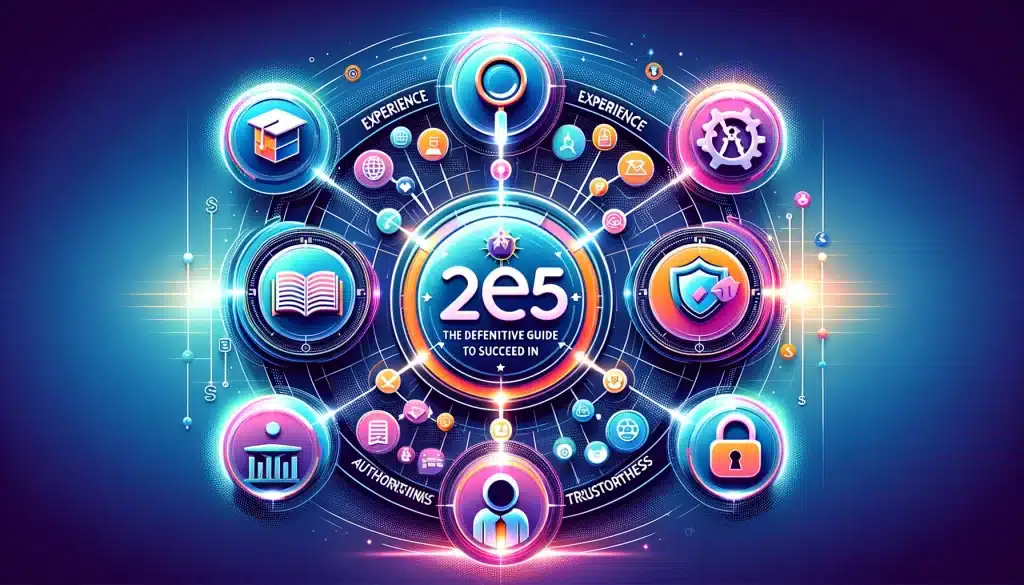
Internal and external linking strategy
Links can reinforce the perception of your website as an authoritative source.
- Internal links: Connect relevant articles within your site for easy navigation.
- External links: Add references to reputable websites to support your claims.
- Avoid broken links: Make sure all links are active and lead to useful content.
Practical example:
An article about marketing may include a link to an official Google guide on marketing strategies seo to strengthen credibility.
Improved user experience (UX)
The way users interact with your website directly impacts their perception of it. EEAT.
- Charging speed: Optimize your site to ensure fast loading time.
- Responsive design: Ensures that the site works perfectly on mobile and other devices.
- Interactivity: Add tools like quizzes, calculators, or surveys to increase engagement.
Practical example:
A fitness blog includes an integrated calorie calculator, improving user experience and retention on the page.
EEAT in emerging sectors and future trends
EEAT in emerging sectors
Artificial Intelligence and advanced technology
The massive use of artificial intelligence poses challenges to guaranteeing the veracity and transparency of machine-generated content.
- Practical example: AI-based platforms, such as ChatGPT or automated content generation tools, must display verifiable sources and inform users about the origin of the content.
- Strategy: Publish content combining automated generation with human oversight to ensure accuracy and relevance. Adding clear references to research and external sources will improve the perception of credibility.
Sustainability and environment
With increasing environmental awareness, brands dedicated to sustainability must adopt transparent practices to build trust.
- Practical example: A company that produces recyclable materials can include official certifications, such as the FSC seal or ISO certificates, to guarantee the positive environmental impact of its products.
- Strategy: Share sustainability reports, include expert testimony, and reference international regulations to demonstrate commitment and authority in the green sector.
Metaverse and Virtual Reality (VR)
The metaverse is emerging as one of the most influential new digital spaces. In this context, trust and transparency are fundamental for users interacting with virtual content.
- Practical example: A platform that offers VR experiences must clearly inform about the use and protection of user data.
- Strategy: Develop practical guides and tutorials that help users understand how to navigate and interact in secure virtual environments. Adding references to data protection regulations and policies can reinforce the perception of reliability.
Future trends of the EEAT
Growth in voice searches
Virtual assistants like Alexa, Google Assistant or Siri are changing the way people consume information, prioritizing accurate and reliable results.
- Impact on the EEAT: Voice search results need to be clear and direct, as users don't have immediate access to multiple sources to cross-check information.
- Strategy: Optimize content for voice searches with structured data, concise answers, and natural language that addresses frequently asked questions.
Content customization
The use of big data and artificial intelligence allows for highly personalized content to be offered, but this brings challenges in terms of privacy and ethics.
- Impact on the EEAT: Users trust brands more that clearly explain how they manage their data and how it is used to personalize content.
- Strategy: Include transparent notices about data use and integrate options so that users can control content personalization.
Stricter regulations on digital content
Legislation on data protection and the regulation of digital content is evolving, especially in the European Union with regulations such as the GDPR.
- Impact on the EEAT: Companies must demonstrate that they comply with current laws to generate trust in users and avoid sanctions.
- Strategy: Add labels and certifications that show regulatory compliance and include updated privacy pages and legal notices.
Adaptation of the EEAT to the new digital generations
The generations Z i alpha They have very different ways of consuming content compared to previous generations, prioritizing interactivity, authenticity and social values.
- Interactive content: Create formats that include videos, quizzes, infographics and other dynamic visual elements.
- Use of authorized influencers: Work with influential people who represent values aligned with the brand and are considered an authority by the target audience.
- Social and ethical impact: For these generations, the values of sustainability, inclusion and social impact are as important or more important than the product or service itself.
The EEAT it has become an essential pillar for any strategy seo of success Work the experience, expertise, authority and reliability It not only improves rankings, but also establishes relationships of trust with users.
If you want to go deeper into optimizing your website, explore our services. seo professional or contact our team of experts for personalized consulting.

